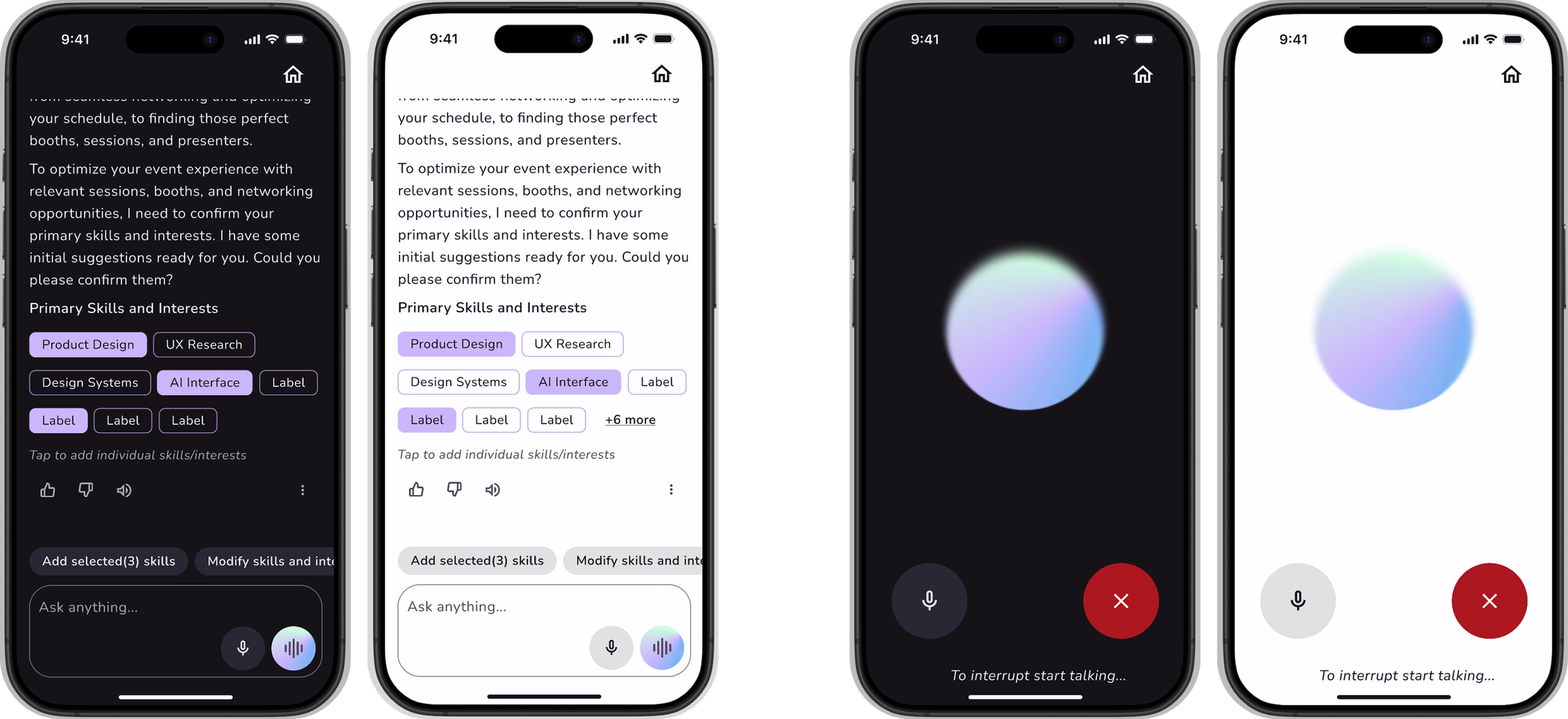Transforming the way Event Attendees experience conferences and events with Eventz.ai , an AI-powered event session discovery and networking platform.
My Role: Product Designer, XiPhi.ai
Team: Me, 1 Design Manager, 1 Data Expert, 1 Software Engineer, 1 ML Engineer
Timeline: Jun - Aug 2025
Contribution: End-to-end AI Conversational Assistant Design, Visual Design, Accessibility Checks, AI Conversational Flow, Defining Success & AI UXEvals
Impact
Achieved a 3X increase in the speed of ideation and prototyping by integrating AI-powered workflows.
Reduced the AI conversation length by 50%, ensuring users receive their first recommendation with minimal friction.
Streamlined the user journey, requiring users to answer only 3-4 questions on average before receiving personalized recommendations.
Ensured the application fully adheres to WCAG 2.0 accessibility standards, creating a more inclusive user experience.
CHAPTER 0: OVERVIEW
Project Overview
Attendees at professional events struggle with an overwhelming event experience from scattered agendas, difficulty finding relevant sessions, a constant state of FOMO (fear of missing out), and post-event "follow-up fatigue." The traditional event website offers all information at once, but with no guidance or personalization, leaving attendees feeling disoriented and disconnected.
Eventz.ai app set out to transform the way attendees experience conferences and events. Our goal is to design an AI-first event assistant app that would personalize, guide, and streamline the user journey.
CHAPTER 1: RESEARCH SYNTHESIS
Research Goal: Identifying attendee user’s key painpoints through attending events.
Design team conducted qualitative interviews with 5 users and synthesized insights to discover key problems through user journey from Pre-event, Event arrival, During event and Post event stage.
Attendee User Journey Map (Click on image to enlarge)
How might we help users find the relevant session, booths and people to network with?
Key User Painpoints
Pre-Event: Overwhelming agendas and difficulty finding relevant sessions or people.
During Event: Confusion with navigating venue for sessions, booths, and difficulty making meaningful connections.
Post-Event: "Follow-up fatigue" and poor knowledge retention.
CHAPTER 2: IDEATION & SUCCESS METRICS
Solution Idea Proposal: Provide users with personalized relevant AI recommendation using AI chat assistant.
Underlying Hypothesis: A well-prepared attendee is more likely to have a high-value experience.
CHAPTER 3: VISUAL & UX DESIGN
AI-accelerated design process: Quick AI-enabled Prototyping, Peer Review and Team Feedback, Design Iterations
Quick AI Prototyping with Figma Make (Click on image to enlarge)
This served as a solid foundation for in-depth idea discussions, critique, and analysis of effective & ineffective elements.
Advantages of AI-prototyping
Using FigmaMake to efficiently translate ideas into designs.
Note: Relying solely on AI did not yield optimal outcomes; providing precise instructions aligned with my design principles and aesthetics was the key.
Color scheme iterations (Click on image to enlarge)
Talk mode interface iterations (Click on image to enlarge)
Final Designs
AI Talking
User Talking
CHAPTER 4: CONVERSATIONAL DESIGN
Implemented Google's PAIR (People + AI Research) guidelines for effective conversation design. Our AI Conversation should be functional, transparent, trusting, context-aware, adaptive and handle errors gracefully.
Pre-event conversational flow for Recommendation
CHAPTER 5: ENGG. HANDOFF & USABILITY TESTING
Engineering Handoff
Progressive handoff for design and development to work simultaneously.
Figma Dev Mode for annotations and interaction
Informing Design Updates
Functional Testing & Accessibility Testing for interfaces in production.
A/B Testing Process: Group A (Control) will receive a generic, non-personalized list of popular sessions and speakers. Group B (Test) interacts with the conversational AI to generate personalized recommendations based on their stated interests (e.g., job title, industry, topics they select).
Track the number of sessions, speakers, and contacts each user adds to their personal agenda for pre-event stage.
To know more on this connect at zealsheth13@gmail.com
CHAPTER 6: IMPACT & REFLECTION
Impact
Achieved a 3X increase in the speed of ideation and prototyping by integrating AI-powered workflows.
Reduced the AI conversation length by 50%, ensuring users receive their first recommendation with minimal friction.
Streamlined the user journey, requiring users to answer only 3-4 questions on average before receiving personalized recommendations.
Ensured the application fully adheres to WCAG 2.0 accessibility standards, creating a more inclusive user experience.
My Learnings
Designing multimodal, responsible, context-aware and adaptive AI interface.
Designing humans and probabilistic AI to work together.
End-to-end product design strategy.

